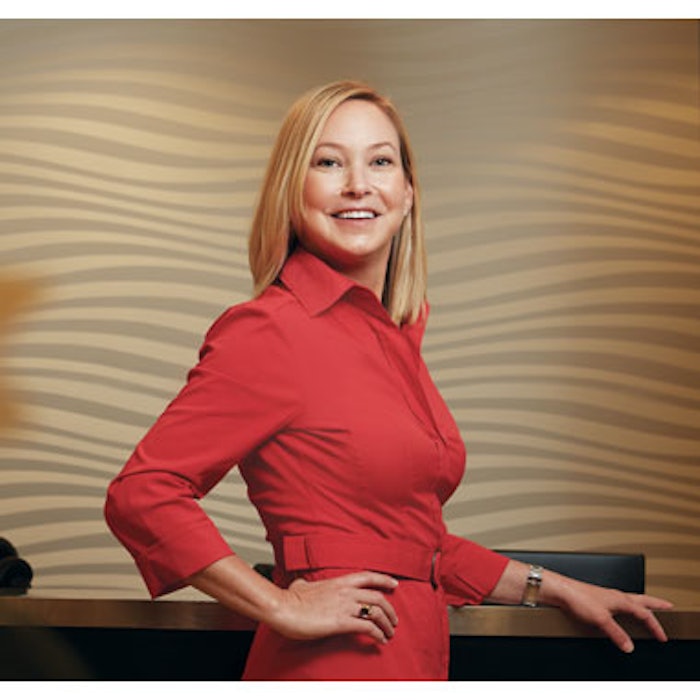
Joely Kaufman, MD, never expected to run her own private practice. In high school, she dreamed of becoming an artist—a plan her parents strongly discouraged. “They said, ‘Are you crazy? You’ll never get a job,’ so I went toward science,” says Dr. Kaufman. “Originally I wanted to be a physicist, then a pathologist.” After being accepted at the University of Miami Miller School of Medicine, she was drawn to the school’s well-regarded dermatology department and soon found herself on a course that would lead her to join and eventually take over the management of Skin Associates of South Florida in Coral Gables, a private practice with five dermatologists and more than 25 staff members.
“The University of Miami has an incredible dermatology department, and that’s where I realized that dermatology really is an art, because you have to read patterns,” says Dr. Kaufman. “Certain rashes and moles have specific patterns and when you look at skin under a microscope, you’re looking for particular patterns in order to diagnose skin concerns. And, of course, cosmetics is mostly artistic. It’s not about filling in a tiny wrinkle; it’s about redesigning the angles and contours of the face.”
Following medical school and residency, Dr. Kaufman pursued a career in academics, “because I loved research, and I thought it would be very difficult to continue that and go into private practice at the same time,” she says. Six years into her career, Fredric Brandt, MD, a university faculty member and founder of Dr. Brandt & Associates and the Skin Research Institute in Coral Gables, reached out to her. “He called me and said, ‘Please come look at my Institute because I’d like you to work with me,’” she recalls. “When I visited, I saw that he was doing as much research as I was doing in an academic setting, and I realized I could have the best of both worlds.”
The two worked together for eight years, welcoming new physicians Jeremy B. Green, MD, and Christopher O’Connell, MD, before tragedy struck in 2015.
“Dr. Brandt’s death was sudden and unexpected, so very little planning had taken place. It was a sudden transition,” says Dr. Kaufman, who took over the practice following his death.
Fulfilling a New Role
With no transition period, Dr. Kaufman’s first priority was to keep the practice running smoothly and do everything she could to retain both patients and staff. “Priority No. 1 was communication with our patients, and No. 2 was communication with the staff and among the physicians so everybody knew exactly what was going on,” she says. “In the beginning, we had meetings much more frequently than we had in the past and, in those meetings, we discussed plans for the future and let staff members—some of whom had been with Dr. Brandt for 25 years—know that their jobs were secure.”
The physicians personally contacted all of the practice’s patients. “We sent a personal letter to every single patient letting them know that we were here, and the doors were still open. We knew which patients had been with Dr. Brandt long term and came in frequently, and we called each of them personally to let them know what had happened and that we were here to take care of them,” she says. “We worked really hard every day to fit everyone in. Our priorities were to retain patients, retain our staff members and to honor Dr. Brandt’s philosophy of care, which is to always look for the next best way to do something and remain at the forefront of research.”
To that end, the Skin Research Institute remains very active. “Like Dr. Brandt, we were all very involved in academics, and this is what attracted us to the practice. Some of our trials are developed in house based on our own ideas; some of them are FDA clinical trials,” says Dr. Kaufman. “Right now, we have laser, toxin and dermal filler trials going on. We’re also investigating a cellulite injectable. Being involved in research makes you a better and more innovative dermatologist. It encourages you to think outside the box and helps you understand the science behind the drugs and devices.”
Photo by Jeffery Salter.
[pagebreak]
Having the research facility on site offers additional benefits for patients seeking the most effective treatments. “We have a confocal microscope in the office, which is used mostly for research,” says Dr. Kaufman. “But it’s fun—and really interesting—to take a patient who undergoes PRP, for example, and look at her skin under the microscope. Most people judge the results based on how the patient feels about the outcome. But the confocal microscope lets us look at changes in the skin and evaluate some of these new procedures without taking a biopsy. The most unique thing about us is that we’re a cosmetic practice but also very science-based.”
The practice is 85% cosmetic dermatology and 15% general dermatology, and now includes five dermatologists. Jacquelyn Dorsal, MD, and Cynthia Golomb, MD, who works one day a week, are the most recent additions. The practice was renamed Skin Associates of South Florida in early 2016, “because we all work together,” says Dr. Kaufman. “We bounce ideas off each other, we help each other and if there is a new device, one physician investigates it and goes for training to see if it’s right for our practice. We’re able to cover a lot of ground because we function as a team, not as individuals in private practice. I have an office manager and a projects manager—and then on the research side we have a director of research. I see patients every day and then coordinate with my team to make decisions.”
In addition to treating patients and taking part in re-search, the doctors at Skin Associates are also carrying on another tradition started by Dr. Brandt: the monthly journal club.
As part of the practice’s monthly doctors’ meeting, each physician picks an interesting journal article to share. “It doesn’t have to be from a medical journal; it could be from another industry,” says Dr. Kaufman. “We look for interesting articles and share what we find. We accomplish so much more having five physicians on board in terms of staff training and understanding new procedures. We have so many brains, and so many sets of eyes and ears out there at all the different meetings.”
The physicians try not to overlap in terms of which con-ferences they attend, so they can bring back a wide range of information. “This is true of procedures too,” says Dr. Kaufman. “It’s hard to be a specialist in every procedure so, for example, Dr. Green is the only one who performs Cellfina cellulite treatments.”
The doctors refer patients to each other based on their chosen procedures, which offers multiple benefits. “It allows each of us to tailor our practice to what we love doing without turning patients away,” says Dr. Kaufman. “We get to become highly skilled in the procedures we perform, and it encourages patients to become comfortable with other physicians in the practice.”
Completing the Transition
A few months after Dr. Brandt’s death, Skin Associates of South Florida created a high-end, glossy newsletter that was mailed to all patients. “It re-introduced the doctors and highlighted some of the technologies we use and the procedures we perform,” says Dr. Kaufman. “We wanted to remind patients who hadn’t been back that the office was still very active and successful, and that we were continuing to innovate by adding new procedures and performing new research through the Institute.”
After one year, Dr. Kaufman sent a personal letter to patients who had not returned. The letter included a dis-count offer to come back in and meet the physicians at the practice. Through these continuing efforts, “our retention rate for both staff and patients has been very, very high,” says Dr. Kaufman.
The practice depends on word of mouth, PR and open house events to attract new patients and, while Dr. Kaufman was careful to respect all the things that patients loved about Dr. Brandt’s practice, she and her colleagues have made some minor tweaks to make the practice their own. “Because we’re a younger group, the office does have a little bit of a different flair,” she says. “We’re a little more tech savvy, so we redesigned the website, created social media pages and started blogging. As for the physical changes to the office, we made those more gradually.”
Photo by Jeffery Salter.
[pagebreak]
The practice remains in the same location with the same layout, but Dr. Kaufman and the other physicians are making minor updates, such as new chairs and lighting fixtures, plus new paint colors to brighten up the rooms. “People come in and say, ‘Oh my gosh, the office looks better than ever,’” she says. “But we made the upgrades slowly so patients would be comfortable.
“Our main focus in the practice is providing the best care from the time you walk in the door to the time you leave,” continues Dr. Kaufman. “We’ve steered away from a high-volume practice to focus more on quality and less on quantity.”
After successfully navigating some unexpected moves from art to science, pathology to dermatology, and then academics to private practice management, Dr. Kaufman is thrilled with the opportunity Dr. Brandt provided and the team he helped create. “I love that this practice has a synergistic approach to cosmetic dermatology, that we truly are a team and that we all benefit from each other’s knowledge and perspective,” she says. “It keeps us energized and it keeps our minds active.”
Inga Hansen is the executive editor of MedEsthetics.
Photo by Jeffery Salter.











